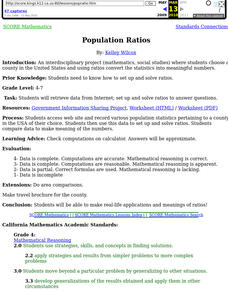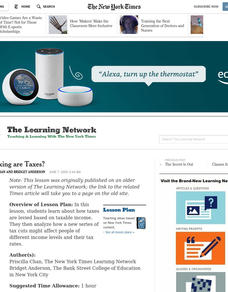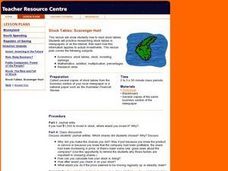Curated OER
Fractions, Decimals, and Percentages Got You Down? "Tri" This!
Students explore number sense by creating a math presentation in class. In this parts of a whole lesson, students define and discuss the relationship between fractions, decimals and percentages before completing a problem worksheet in...
Curated OER
Making Blood!
students research blood's components, and use their math skills to recreate a model of whole blood using commonly found food items.
Curated OER
Baseball Statistics
Students take an in depth examine baseball record breakers. They calculate statistics, not just for one year, but over whole careers, to compare some famous players and find who was the best all-time home run hitter.
Curated OER
The Discount is Right
Students visit various websites and calculate various prices of five items. They estimate the sale price of five items using the original price and discount rate, use percent to calculate the rate of discount and the original price, and...
Social Media Toolbox
Twitter Time
Tweet all about it! Junior journalists explore the Twittersphere to determine its effectiveness as a news broadcasting tool in the 12th installment of the 16-part Social Media Toolbox. Participants follow and record their observations of...
Curated OER
Apple Estimation: Percentages & Subjective Reasoning
Students practice using their estimation skills by utilizing apples. In this percentage lesson, students utilize a scale and an apple to discover the percentage of each bite they take. Students share their data with the rest...
Curated OER
Population Ratios
Students access web site and record various population statistics pertaining to a county in the USA of their choice. They use this data to set up and solve ratios. They compare data to make meaning of the numbers.
Curated OER
How Taxing are Taxes?
Students explore the ways that taxes are levied based on taxable income. They analyze how a new series of tax cuts might affect people of different income levels and their tax rates.
National Wildlife Federation
Wherefore Art Thou, Albedo?
In the sixth instructional activity in a series of 21, scholars use NASA data to graph and interpret albedo seasonally and over the course of multiple years. This allows learners to compare albedo trends to changes in sea ice with...
The New York Times
Making Do: Learning and Growing Through Adversity
What is it that makes people keep going when they face challenges in life? Ask your class to consider this question in relation to their own experiences and as they read material from The New York Times. Using personal experiences...
Curated OER
Race and Ethnicity in the United States
Students explore race and ethnicity as it is defined by the U. S. Census Bureau. They compare data from 1900, 1950, and 2000 and identify settlement patterns and changes in population. In groups, they map these changes and discuss...
Curated OER
Salaries
Students are engaged in the study of salaries and how they vary according to different occupations. They conduct research using a variety of resources in order to summarize the earnings potential in the human services field.
Curated OER
Time Management
Students plot activities for a 24 hour day. They record their information on a spread sheet program. Students list categories they use and write equations for cells that add cells of each category together. Students create a pie chart of...
Curated OER
Proving For The Crew
Students write math questions that pertain to the Lewis and Clark Expedition. For this math lesson, students utilize resources in the classroom to help write mathematical questions and answers that relate to the Lewis and Clark...
Curated OER
Sea Ice: Unscrambling the Egg Code
Students determine sea ice thickness, concentration, and floe size by reading egg codes. In this sea ice conditions lesson, students color code a map based on prescribed criteria and use the maps to identify changes in sea ice...
Curated OER
Stock Tables: Scavenger Hunt
Young scholars investigate how to read stock tables and research stock tables in newspapers or on the Internet. They discuss how they would invest $1000 in stock, examine how to keep track of their shares online, and complete a...
Curated OER
WHAT'S ORGANIC?
Middle schoolers explore how certain foods come to be certified "organic." They write the words "organic" and "synthetic" and given the definitions of each. Students are given dictionaries. They are asked: "What is organic food?" Middle...
Curated OER
Let's Take a Trip!
Sixth graders plan trip for family of four, and choose best travel plan by studying maps, considering different routes, and visiting Web sites to get airline and travel schedules.
Curated OER
Children at War
High schoolers conduct Internet research to investigate the use of children in combat throughout the world. Students read personal testimonies and analyze media coverage of children in combat.
Curated OER
Utah at the Crossroads: Challenges for K-12 Education in the Coming Ten Years
Students discuss the difficulties in financing public education in Utah. They examine how Utah students perform on standardized tests. They focus on the coming enrollment boom in K-12 education and slowing economy and what effects these...
Curated OER
Ecosystems
Students create plots of land in three different ecosystems and use AppleWorks to collect data for research. This lesson includes a downloadable worksheet and can be accomplished in four days.
Curated OER
What's Occurring in Sudan?
Students participate in an activity designed to show them how minority groups are discriminated against in Sudan. In groups, they read stories about the Sudanese rebellion and complete worksheets.
Curated OER
Why Care About Amphibian Population Decline and Malformations?
Students examine the reasons for preserving wildlife. They look at reasons for amphibian malformations and write an essay about the ethical issues that this brings up. They listen to the teacher read quotes about extinction and how the...
Curated OER
Fraction Card Shark
Second graders explain the relative size of fractions using symbolic and concrete representations. Groups of four students play a game which uses cards and unifix cubes. The game helps them get a visual understanding for the 'size' of...























